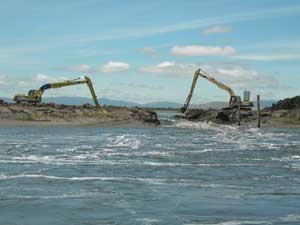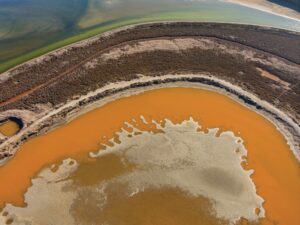We are somewhere west of the Napa River, nosing in a small boat along a slough between hollow islands known as Pond 2 and Pond 5, trying to grasp just how much has changed hereabouts in the last 24 months.
Just as you would have three years ago, you experience only a narrow, reed-fringed channel under a big, bright sky. The tide is high and the levee tops seem fragile and low. Now and then a power line, a leaning hunter’s shack, or a glimpse of the Napa River Bridge reminds you of the urban world not far away. It takes a sharp eye and the knowledge of a guide like our pilot, Greg Green, to read signs of change. Here, for instance, a line of survey stakes extends into the water. The outermost stake once marked the edge of bordering tules that since have been torn away. Carrying more flow than it used to, this slough is widening. “That’s what we’re looking for,” says Green. “This system has had restricted breathing for the last 100 years, and now the restoration project is opening it up.”
Coming around a corner, we see some of that current pouring through an opening, made just a few weeks ago, into the interior of the former Pond 5. In March 2006, the pond was drained of its brine. Then bulldozers and backhoes brought in on barges accentuated the courses of old interior sloughs that will resume their function as the arteries of a new marsh, plugged unwanted old ditches, and shaved the top off several levees so the highest tides will swamp them. The reduced dikes will support plants like marsh gumplant, providing high-tide refuges for salt marsh harvest mice and clapper rails; the occasional drowning will kill off unwanted weeds.
- After decades of being cut off from Napa Slough, Pond 5 was openedto tidal influence in mid-2006, when excavators opened several breachesin the surrounding levees. Photo by Mike McFadden, Cooper Crane and Rigging.
We stop on the opposite bank of China Slough and climb that dike to see another kind of restoration. Beyond is a still sheet of open water, just deep enough to support a fine stand of widgeon grass, favored feeding ground for ducks that dive for a living, like the canvasback. As much as 90 percent of the canvasback population in San Francisco Bay has been counted on Pond 2. Here the strategy is not to change the habitat but to protect it by strengthening eroded dikes.
A few miles down China Slough, an older opening into the space known as Pond 3 shows a later stage of marsh evolution. When we turn into the breach, canvasbacks, pintails, and whimbrel rise at our approach. There’s a big crowd of godwits and other shorebirds on a shaved-off levee slope. Even on this high tide, patches of mud and vegetation are appearing. “This one is quickly progressing to a tidal marsh,” says Green.
It’s a satisfying end to what seemed like years of stasis.
Improvisation to Restoration
The State Department of Fish and Game (DFG) had long hoped to acquire the Cargill salt ponds as the key to restoring the Napa-Sonoma Marshes, the wetland expanse west of the Napa River. When the hope was realized in 1994, the new managers found they had a tiger by the tail. They had far too little money, far too little information, and too much of one thing: salt.
Salt ponds are, not surprisingly, salty. Up to a point, this is a fine thing for wildlife. But the final stops in the 12-pond Cargill system were pretty sterile places. Salinity buildup at the north end had created a weird scene of rust-orange waters, dead trees, and salt-encrusted embankments. The pond with the unlucky number 7 was a true toxic sump; it had been the dumping ground for bittern, the toxic solution that remains after sodium chloride has precipitated out of water.
Cargill was gone, but the salt-making machine it had built could not simply be shut down. Without a continual input of new water, the ponds would eventually dry up, losing all their value for birds. So the state managers continued to pump water north from the bay. Yet every added gallon brought with it its quantum of dissolved minerals, which were no longer being removed at the end of the line. If this process continued indefinitely, one pond after another would go the way of the poisoned northern ones.
The wholesale breaking of dikes was really not in the cards either. Next door to the ponds was the Napa River, itself an important fish habitat and protected waterway. Even the fresher ponds were mostly too briny for casual discharge. Nor was there yet any scientific basis for deciding which ponds should be restored to marsh and which should be retained as open water.
Needed, obviously, was a great deal of study, a careful plan, and a very large budget (eventually pegged at $100 million). While these ingredients were painfully coming together, the word of the day was “improvise.”
Chief improviser was Tom Huffman, manager of DFG’s Napa-Sonoma Marshes Wildlife Area. With his camouflage clothing, blond beard, and duckbill cap inadequate for the sun exposure he gets, he has the look of a fellow whose days are spent outdoors—many of them on these sloughs, where he was busy tending a terminally creaky apparatus. Dikes were leaking and eroding. Siphons linking the various ponds were prone to plugging, and pumps were underpowered. Huffman recalls once fixing a failing tidal gate with a piece of scrap metal picked up beside the highway. “When I look back on my career,” he says, “one of the things I’ll be most proud of is that I kept it going as well as I did, on as little as I did, for as long as I did.”
Behind the scenes, though, help was on the way. State bond measures approved in 2000 and 2002 included funds for restoration of wetlands around San Francisco Bay. The Coastal Conservancy, armed with bond money and long expertise at shepherding complex deals, was building a partnership including the Army Corps of Engineers and DFG. Engineers were analyzing the ram-shackle system and what might be done with it. Scientists were at work defining which birds and fish benefited from the ponds as they were and as they might be.
By 2003, there was a plan. Four large ponds adjoining the Napa River would be opened to tidal influence and become marsh. Five ponds to the west would continue as open water for the benefit of shore-birds and ducks. (In some cases this required expensive repair of levees and water control structures.) That left the three saltiest northern ponds, including the lethal Pond 7. Here the planners adopted a solution offered by the Sonoma County Water Agency: Highly treated urban wastewater would be mixed with the bittern, shortening the timetable for dilution and discharge.
In 2005, Ducks Unlimited, Greg Green’s outfit, was hired with funding from the state Wildlife Conservation Board to carry out the first phase of the plan. Once begun, the job proved easier and even a little cheaper than expected. In March 2006, at the end of a wet winter, the first “salinity reduction breaches” were made. The brine was easily absorbed by swollen sloughs, and in June the go-ahead came to make all 14 planned levee breaks. The fearsome salt monster seemed to have dissolved in the rain.
And wherever dikes have been breached, the once seemingly unstoppable force of salt buildup has given way to another formidable force: nature’s tendency to build a tidal marsh if given room to build one.
What is happening in the former salt ponds is almost entirely out of the public view. The restoration of the Napa-Sonoma Marshes will really become a presence for people on the day when water reclaims the Cullinan Ranch along Highway 37. This sprawling tract, almost surrounded by the salt ponds but never one of them, has been a farm, the site of a planned city, and now a key asset of the San Pablo Bay National Wildlife Refuge. Plans due out this summer are expected to lead to its full restoration as marsh. The Ducks Unlimited team will be working here, too, probably in 2009.

.jpg)




